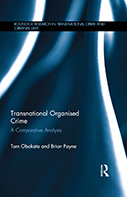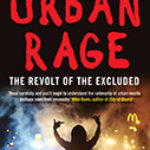Transnational Organized Crime: A Comparative Analysis

Authors: Tom Obokata and Brian Payne
Publisher: London: Routledge, Taylor and Francis Group, 2017. 171p.
Reviewer: Frederick T. Martens | July 2018
It was 2006, when the government of Northern Ireland attempted to impose a pilot project on a local construction company. This was a recommendation by Ronald Goldstock, the former director of New York’s Organized Crime Task Force (OCTF), who argued that the resolution of problems within the construction industry “should be continued and expanded including the use of Independent Private Sector Inspector Generals (IPSIG’s) particularly within the construction industry” (Goldstock, 2004, p.22).
Having been selected to participate in this pilot organized crime project for the government of Northern Ireland in 2006, several of my colleagues and I met with the relevant government authorities and the owner of the construction company upon which this project was being imposed. One of my colleagues began passing out his business cards, when the owner of the construction company suggested he take them back to avoid their finding their way into the hands of the paramilitary organizations that were involved in the extortion of construction companies and small businesses. Then as now, “paramilitary groups (both Loyalists and Republican) or individuals claiming to be from these groups continue to be actively involved in extortion attempts, particularly the racketeering of small businesses and building sites in towns and cities across Northern Ireland” (OCTF, 2017, p. 29). Thus, twelve years later, it appears that the more things seemingly changed, the more they actually stayed the same.
When asked to review Tom Obokata and Brian Payne’s assessment of Northern Irelands’ organized crime control efforts, I embraced the opportunity to revisit that failed project—one that never did prove a viable option, for a number of reasons.
Conducting research on organized crime relies for the most part on access to what are often referred to as “sensitive and confidential” law enforcement records. In the course of conducting this research, scholars such as Obokata and Payne are obliged to enlist the “good will” of those upon whom and about whom the research is being conducted. Police, prosecutors, and judges, criminal informants, and “connected” sources of information often comprise the research universe. And, maintaining the relationships over time can prove valuable for future research projects.
In the course of conducting research, researchers are often channeled into confining their inquiries into how these various actors choose to define or perceive their respective organized crime “problem.” “Making cases,” “arresting criminals,” and “seizing assets” often spell success or failure in the bureaucratic world of organized crime enforcement. Strategic success usually takes a back seat to tactical results—the means by which budgets are driven. Indeed, what is not pursued is often more important than what is. This is clearly the case in Obokata and Payne’s government-funded research, notwithstanding their undeniably robust and rich understanding of the law and the enforcement thereof.
Unfortunately, when Obokata and Payne claim “there is no doubt that Northern Ireland and the Republic of Ireland have been making good progress in tackling organized crime, both in terms of legislative frameworks and law enforcement practice,” not only do they fail to provide the measurement criteria that were used to arrive at this far-reaching conclusion, but they have bought into the classic argument that arrests for vice-related crimes (i.e., narcotics and drugs, prostitution, human trafficking, etc.) equate to organized crime enforcement.
Nobel Prize -laureate Thomas Schelling perhaps said it the best: “organized crime is monopoly crime” (Schelling 1967; 1971). Acquiring and maintaining a criminal monopoly is the ultimate goal of a criminal organization. Often-times, the police and criminal justice system are complicit, either consciously or inadvertently, in allowing criminal markets to consolidate to ensure “market exclusivity.” Extortion is the favored method for ensuring market domination. This is a crime, as the Organized Crime Task Force (OCTF) of Northern Ireland points out, that is underreported by civil society for fear of violent retaliation (OCTF, p. 29).
Wisely, Niamh Hourigan and his colleagues recently addressed this defining characteristic head-on, finding in their study: “[t]he rise of significant levels of organized crime is a relatively recent phenomenon in both the North and South of Ireland…Criminal networks have been also involved in `…tiger kidnapping, [and] extortion [emphasis mine]…’— crimes that instill fear in legitimate businessmen and civil society, as well as competing criminal entrepreneurs” (Hourigan, et al., p. 142). Obokata and Payne, unfortunately trapped by what was provided to them by law enforcement, never captured this important dimension. Notwithstanding this critical omission, Obokata and Payne nevertheless do provide a scholarly and legally-technical assessment of organized crime legislation and regulation across culturally-diverse borders, including New Zealand, Australia, Denmark, Egypt, India, Africa, and many more sovereign jurisdictions.
The authors compare and contrast the multitude of definitions attempting to capture the nomenclature of organized crime. As they point out, the United Nations Convention against Transnational Organized Crime “does not provide a definition of organized crime per se but rather it is to be understood as a ‘serious crime’ committed by an ‘organized criminal group’ and is defined as: [A] structured group of three of more persons, existing for a period of time and acting in concert with the aim of committing one or more serious crimes or offences established in accordance with this convention, in order to obtain, directly or indirectly, a financial or other material benefit” (pp. 9-10).
Ironically, the authors found that “the absence of a legal definition (of organized crime) has not had a negative impact on law enforcement against organized crime in Northern Ireland. The law enforcement officers have been able to distinguish organized crime from ordinary crime by using a mechanism known as CRIMENET, which provides detailed information on organized crime and criminal groups.” (p.55). Claiming that CRIMENET is “explained in Chapter 3” (p.80), the authors casually mention it, but actually never provide a thorough appreciation or description of its probative value.
The seeming obsession with definition that as gone on forever undeniably masks the conceptual character of organized crime. One need not be consumed with definitional precision to recognize that organized crime represents a unique form of crime that essentially seeks to constrain competition usually through corrupt alliances with the agents of social control (i.e., police, prosecutors, and judges). Nullification of the criminal justice processes represents the discriminating feature of organized crime. Remarkably, this aspect of organized crime receives scant attention by these authors— again a glaring and inexcusable omission, particularly given the public’s suspicion of criminal justice institutions and the “culture of fear” that continues to pervade Northern Ireland as well as the Republic itself (See Conway, 2014:90).
Because law enforcement expends significant resources addressing the transnational nature of drug trafficking, the authors were compelled to pursue this issue. Differences between Northern Ireland and the Republic of Ireland in sentencing drug offenders are stark (p. 72). They cautiously broach the subject of decriminalization and/or legalization, arguing “many stakeholders, including politicians, agree that current drug laws and policies are not working properly. There is, therefore, some merit in discussing and analyzing the effectiveness of alternative approaches such as decriminalisation and legalisation which are more based on scientific evidence as well as paying due regard to the voices of citizens” (p. 74). In short, the status quo will persist, despite the fact that OCTF contends that “for the second consecutive year there has been an increase in the number of seizures of heroin as well as the amount of heroin seized…deaths as a result of drug misuse continue to be a concern…with a variety of both illegal and prescription drugs suspected of being a contributory factor in a number of deaths in Northern Ireland” (OCTF, p. 10).
It would seem that any comparative analysis of transnational organized crime would address the competing criminal enterprises that comprise the Republic and Northern Ireland’s organized crime milieu. Regrettably, criminal enterprises are dealt with by Obokata and Payne solely in terms of arcane legislative proscriptions.
The authors summary conclusions are that there is little definitional harmonization between political jurisdictions; inter-jurisdictional cooperation usually occurs on an informal basis insofar as “state sovereignty is dominant”; laws on electronic surveillance and their judicial admissibility reflect cultural parochialism and operational imperatives; witness immunity and witness confidentiality/protection are jealously guarded; drug trafficking seems to be the predominant criminal activity that consumes the law enforcement establishment; human rights violations are a sensitive subject and conditioned on how the respective jurisdictions perceive their organized crime problem; money laundering and the confiscation of illegal proceeds are often conflated between revenue and enforcement agencies; secret trials and anonymous juries often result in discriminatory treatment; cigarette smuggling and gas tax fraud are a product of excessive taxation; and human trafficking legislation between the Republic and the North are in need of more harmonizing sanctions.
Recognizing the futility of arrest and prosecution as the only means for addressing transnational organized crime, Obokata and Payne do call for a more inclusive approach enlisting “the participation of civil society organizations with relevant expertise and experience…This truly multi-agency approach would strengthen action against transnational organized crime in the island of Ireland” (p. 151), they say.
Perhaps in time, the aforementioned IPSIG concept as well as other harm reduction modalities will be viable options in mobilizing the resources of the private sector in addressing the systemic effects of transnational organized crime. Hope springs eternal, even if history may will be less forgiving.
Frederick T. Martens is a former president of the International Association for the Study of Organized Crime (IASOC). He was contracted to establish an Independent Private Sector Inspector General (IPSIG) in Northern Ireland in 2006.
References
Conway, Vicky. 2014. Policing Twentieth Century Ireland: A History of An Garda Siochana. Abingdon: Routledge.
Goldstock, Ronald. 2004. Organized Crime in Northern Ireland: A Report For The Secretary of State and Government Response. Belfast, Ireland: Organized Crime Task Force.
Hourigan, Niamh and John F. Morrison, James Windle, and Andrew Silke. 2018. “Crime in Ireland north and south: Feuding gangs and profiteering paramilitaries.” Trends in Organized Crime. London: Springer.
Ianni, Francis A.J. and Elizabeth Ruess-Ianni. 1972. A Family Business: Kinship and Social Control in Organized Crime. New York: Russell Sage Foundation.
Organized Crime Task Force. 2017. Annual Report and Threat Assessment: Organized Crime in Northern Ireland. Belfast, Ireland.
Schelling, Thomas C. 1967. “Economic Analysis of Organized Crime.” Task Force Report: Organized Crime. Washington, D.C.: Government Printing office; also “What is the Business of Organized Crime?” 1971. The American Scholar. Pp.643-652.
Woodiwiss, Michael. 2005. “Transnational Organized Crime: The Global Reach of an American Concept.” In Edwards A and Gill P. (eds), Transnational Organized Crime: Perspectives on Global Security. Routledge.


